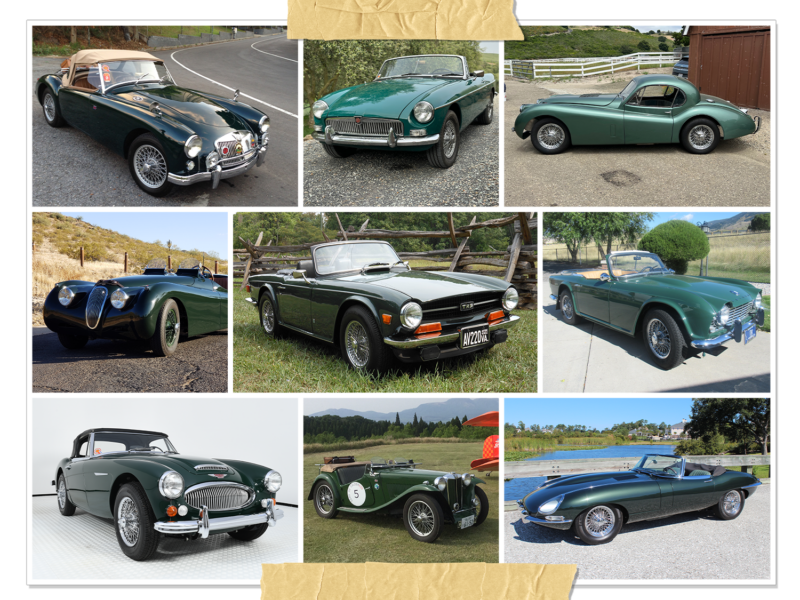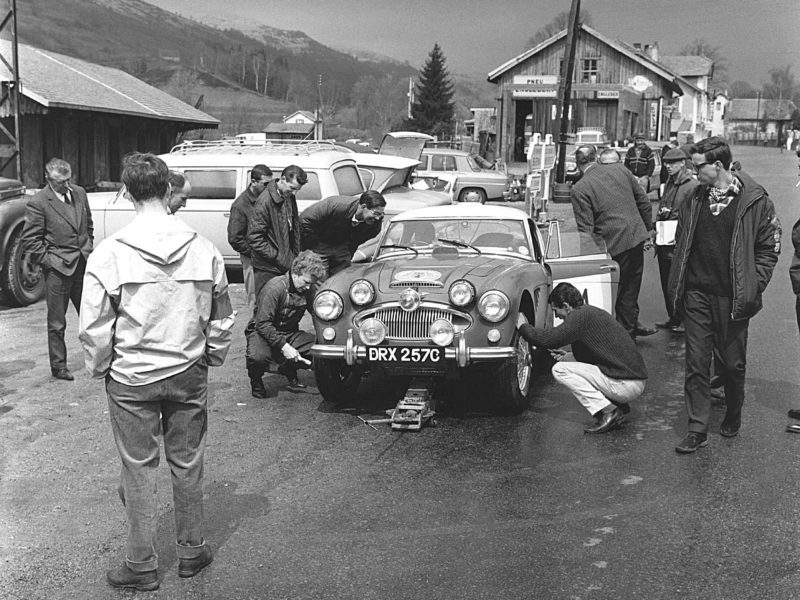Originally printed in the 1959 issue of Road Test Magazine
In a country like the U.S., where change is often made just for its own sake, not every import which has remained basically unchanged for six years can continue to sell well. Was the Austin-Healey really so good originally, or have refinements kept it abreast of the times?
The only easily visible changes since the first model have been a new grille and hood (instituted in 1957), outside door handles, and a longer top, necessitated by the addition of the two jump seats. The car is actually 2 inches longer because of the chassis and body lengthening to accommodate the two seats, but this is not readily noticeable. Mechanically, the 6-cylinder Austin A-105 engine was installed in place of the older 4-cylinder A-90 engine, which had been used in the car since its inception.
Now, once again, Donald Healey has brought about some detail changes to keep the A-H up with competition. The new model is the Mille Miglia, named after the race in which the prototype car was first run (and driven to second place in its price class, at an average speed of 75.9 mph by Tommy Wisdom).
The chassis and body of the Mille Miglia are unchanged from the 100-6 (tested in the January 1957 issue, now sold out). All refinements are in the engine, which now delivers 117 brake horsepower at 4750 revolutions per minute. It was formerly rated at 102 blip at 4600 rpm. The torque has also been increased from 142 pounds per foot at 2400 rpm to 149 at 3000 rpm. Both power and torque have been raised throughout the speed range, but the greater percentage of improvement is at the upper end.
The chief difference between the old and new engine is in the cylinder head and intake manifold. Separate castings replace the old-style head with its cast-in manifold. Breathing has been much improved by this arrangement, as there are now six intake and six exhaust ports.
The intake ports are round in shape, 1 5/16 inches in diameter, and placed in pairs. Exhaust ports 1 and 6 are rectangular but have the same area as the remaining four, which are round and 1 7/16 inches in diameter.
Two 1%-inch SU model HD-6 carburetors are attached to the aluminum log-type manifold, which is cast with a partition in the center (between ports 3 and 4). A 7/16-inch-diameter hole is cast in this partition to relieve surging in the manifold and equalize the intake charge, in much the same manner as an outside balance tube.
In order to take advantage of the larger carburetors and better porting, the valves have also been enlarged. The intake valves are now 1.75 inches in diameter, as compared to 1.688 in the previous model. Exhaust valves have been increased in size from 1.420 to 1.562.
The compression chamber remains almost the same shape as before but is slightly deeper and has been relieved around the valve seats to aid breathing. The increase in compression ratio—up from 8.25 to 8.50—was achieved by the use of new pistons with higher crowns.
Dual exhaust manifolds are continued as before. Unlike those on the previous model, they exhaust into twin pipes. Two distinct types of sound emanate from these dual pipes. One is a rather pleasant rap similar to the sound of the XK-120-M, but which at certain rpm gets to be quite annoying to the car’s occupants due to the severe “cab noise.” It sounds almost as though the exhaust system were welded to the body. A subsequent check revealed that the sound is not bothersome to people outside the car (especially minions of the law) as we suspected it might be.
The other sound coming from the pipes is that of scraping metal whenever any but the most gradual of driveways is entered. It is a continual source of amazement that the designers of the Austin-Healey have apparently made no attempt to increase the ground clearance of the car in general, or at least of the appendages, such as the exhaust pipes, that could be more easily rearranged.
Getting in or out of the Healey with the top up is still a chore. Fortunately, Healey owners spend more time driving the car than they do getting in and out. Entrance and exit are made much easier when the top is lowered; however, lowering and storing the top takes the joint efforts of a score of trained circus roustabouts.
Once one is in, the true bucket seats are fairly comfortable. The controls are well placed with the exception of the choke, which is hidden alongside the steering column and about midway between the instrument panel and the firewall. Healey engineers must feel that the choke is so seldom used that it doesn’t need to be located on the panel with the other controls. They appear to be right, too, though California is not the best place to determine this.
The drivers seat is adjustable fore and aft (the passenger’s seat is not), and both fold forward to allow admittance to the jump seats from either side of the car. Both front seats are placed in such a manner that the occupants’ heads are between the first and second of the three top bows. In spite of this, everyone who rode in the car managed to crack his head against the top bows at least once. Seat belts would be a distinct aid in this respect, although they are not needed for lateral support. The bucket seats are quite effective in holding the driver and passenger in place.
Handling, control, and riding qualities have not been altered. The ride is on the stiff side, but anyone used to the “sports car ride” will feel right at home. The steering is positive and quick, although a little heavy for so light a car at low speeds, as in town driving.
Visibility with the top down is excellent, as would be expected. It is strongly recommended that a fender mounted rear view mirror be installed because of the limited visibility with the top up. This, of course, is not a condemnation of the Austin-Healey, but would be most practical for any car with the low seating position and somewhat obscured vision inherent with roadster or convertible tops.
During acceleration tests and top-speed runs the car caused no concern to driver and passenger and seemed to be under complete control at all times. Steering was sure, the suspension coped easily with all road irregularities, and the brakes brought the car to a swift, straight stop.
The clutch and 4-speed transmission worked smoothly, fast starts being made with no difficulty. In making the acceleration runs, the rev limit of 4800 was exceeded only in 1st gear and then only by 400 rpm at the most. It is very likely that acceleration times could be improved by extending the car in each gear. It should also be remembered that the additional passenger’s weight adds about a second to the 0-to-60 time.
With the introduction of the MM, the buyer’s only choice now is whether to buy the standard or deluxe version.
The standard MM will come equipped with disc wheels; a tonneau cover and heater are the only available extras. The delivered price (plus tax and license) is $2995 on the West Coast. The deluxe model tested comes in delivered form with wire wheels, tonneau cover, heater, direction signals, telescopic steering column and overdrive. The delivered price with everything is $3395 (again on the West Coast). The standard and deluxe models have the same engine. Prices will be about $100 higher in other parts of the country.
Just what is keeping the Austin-Healey in its place in new-car sales? The combination of good looks, compact size, reliability, adequate performance and reasonable price all add up. Some cars have at least two or three of these attributes to a better degree than the Healey, but none of the others has more good points all wrapped up in one attractive package. This, plus the generally excellent service and parts which are readily obtainable over most of the U.S., must be the answer.







'From the Archives…Road Test: Austin-Healey Mille Miglia' has no comments
Be the first to comment this post!